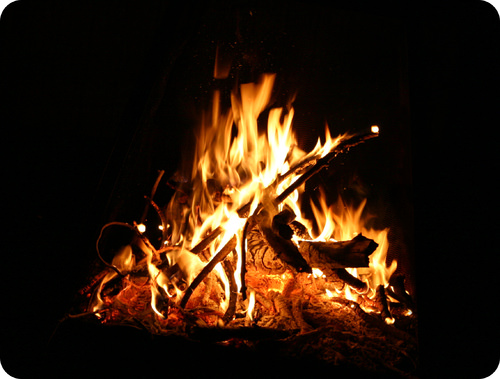17.5 异热和内热过程
章节大纲
-
How do you keep warm?
::你怎么保持暖和?A camp fire is an example of basic thermochemistry . The reaction is initiated by the application of from a match. The reaction converting wood to carbon dioxide and water (among other things) continues, releasing heat energy in the process. This heat energy can then be used to cook food, roast marshmallows, or just keep warm when it’s cold outside.
::营火是基本的热化学的一个例子。 反应是由火柴应用引发的。 将木柴转换成二氧化碳和水(等等 ) , 反应还在继续,在此过程中释放热能。 这种热能可用于烹饪食物、烤棉花糖,或者当外面寒冷时保持温暖。Exothermic and Endothermic Processes
::异热和内热过程When physical or chemical changes occur, they are generally accompanied by a transfer of energy. The law of conservation of energy states that in any physical or chemical process, energy is neither created nor destroyed. In other words, the entire energy in the universe is conserved. In order to better understand the energy changes taking place during a reaction, we need to define two parts of the universe, called the system and the surroundings . The system is the specific portion of matter in a given space that is being studied during an or an . The surroundings is everything in the universe that is not part of the system. In practical terms for a laboratory chemist, the system is the particular chemicals being reacted, while the surroundings is the immediate vicinity within the room. During most processes, energy is exchanged between the system and the surroundings. If the system loses a certain amount of energy, that same amount of energy is gained by the surroundings. If the system gains a certain amount of energy, that energy is supplied by the surroundings.
::当物理或化学变化发生时,这些变化通常伴随着能源的转移。能源保护法规定,在任何物理或化学过程中,能源既不产生,也不破坏。换句话说,宇宙的全部能源都是受到保护的。为了更好地了解在反应中发生的能源变化,我们需要界定宇宙的两个部分,称为系统及其周围。系统是某一空间中正在研究的某个空间中物质的具体部分。周围是宇宙中不属于系统的所有部分。实际上,对于实验室化学家来说,系统是特定化学反应,而周围是室内的近邻。在大多数过程中,系统与周围的能源是相互交换的。如果系统失去一定数量的能源,那么周围就会获得同样数量的能源。如果系统获得一定的能量,则由周围的能量提供。In the study of thermochemical processes, things are viewed from the point of view of the system. A or is endothermic if heat is absorbed by the system from the surroundings. In the course of an endothermic process, the system gains heat from the surroundings and so the temperature of the surroundings decreases. The quantity of heat for a process is represented by the letter . The sign of for an endothermic process is positive because the system is gaining heat. A chemical reaction or physical change is exothermic if heat is released by the system into the surroundings. Because the surroundings is gaining heat from the system, the temperature of the surroundings increases. The sign of for an exothermic process is negative because the system is losing heat.
::在热化学过程的研究中,从系统的角度观察事物。如果热被系统吸收到周围的周围,A或是终端热。在最终热过程过程中,系统从周围获得热量,因此周围的温度会下降。一个过程的热量由字母q表示。由于系统正在变热,因此对内热过程的q表示是积极的。如果系统向周围释放热量,化学反应或物理变化是异温的。由于周围环境正在从系统获得热量,周围环境的温度会上升。由于系统正在失去热量,q对外热过程的表示是负面的。(A) Endothermic reaction. (B) Exothermic reaction.
:A) 内热反应。 (B) 异热反应。
Exothermic and endothermic reactions are all around us. Ever hurt yourself during a game or on the playground and need a cold pack or hot pack? These packs get hot or cold by simply squeezing them. How do they change temperature like that? See if you can figure it out (and make the most efficient hot and cold pack) in this simulation:
::我们周围都是热和热终极反应。 在游戏中或在操场上曾经伤害过自己, 需要冷冻包或热热包吗? 这些包只是挤压它们就会变热或变冷。 他们如何改变温度呢? 看看您能否在这个模拟中找出答案( 并做最有效率的热冷包 ) :Units of Heat
::热量单位Heat flow is measured in one of two common units: the calorie and the joule . The joule (J) is the SI unit of energy. The calorie is familiar because it is commonly used when referring to the amount of energy contained within food. A calorie (cal) is the quantity of heat required to raise the temperature of 1 gram of water by 1°C. For example, raising the temperature of 100 g of water from 20°C to 22°C would require 100 × 2 = 200 cal.
::热流以两个共同单位之一测量:热量和焦耳。焦耳(J)是SI的能量单位。热量是熟悉的,因为它在提到食物中的能量量时经常使用。热量(卡)是将1克水的温度提高1°C所需的热量。例如,将100克水的温度从20°C提高到22°C需要100×2=200卡。Calories contained within food are actually kilocalories (kcal). In other words, if a certain snack contains 85 food calories, it actually contains 85 kcal or 85,000 cal. In order to make the distinction, the dietary calorie is written with a capital C.
::食品中所含的热量实际上是千卡,换句话说,如果某点零食含有85个食物卡路里,它实际上含有85千卡或85,000卡。 为了做出区分,饮食卡路里用资本C来写。
::1千卡路里=1卡洛里=1千卡路里=1 000卡路里To say that the snack “contains” 85 Calories means that 85 kcal of energy are released when that snack is processed by your body.
::说零食“含有”85卡路里的意思是当零食由你的身体处理时,85千卡能量就会释放出来。Heat changes in chemical reactions are typically measured in joules rather than calories. The conversion between a joule and a calorie is shown below.
::化学反应的热变化通常用焦耳而不是卡路里测量,焦耳和卡路里之间的转换见下文。
::1 J=0.2390口径或1 C=4.184 JWe can calculate the amount of heat released in kilojoules when a 400 Calorie hamburger is digested.
::我们可以计算出400卡罗里汉堡被消化后 千焦耳释放的热量
::400 口径= 400 kcalx4.184 kJ1 kcal= 1. 67x103 kJSummary
::摘要-
Processes of heat exchange between the system and surroundings are described.
::说明系统与周围环境之间的热交换过程。
Review
::回顾-
What does the law of conservation of energy say?
::节能法则怎么说? -
What is a reaction called that gives off heat?
::什么是所谓的反应 释放热量? -
A cake is made by mixing ingredients and placing the material in an oven for baking. What type of reaction is involved?
::蛋糕是由混合成分和将材料放在烤炉中烤制成的。
-
Processes of heat exchange between the system and surroundings are described.

